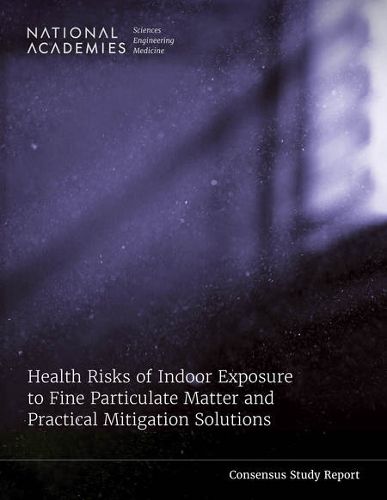Readings Newsletter
Become a Readings Member to make your shopping experience even easier.
Sign in or sign up for free!
You’re not far away from qualifying for FREE standard shipping within Australia
You’ve qualified for FREE standard shipping within Australia
The cart is loading…






Schools, workplaces, businesses, and even homes are places where someone could be subjected to particulate matter (PM) - a mixture of solid particles and liquid droplets found in the air. PM is a ubiquitous pollutant comprising a complex and ever-changing combination of chemicals, dust, and biologic materials such as allergens. Of special concern is fine particulate matter (PM2.5), PM with a diameter of 2.5 microns (<0.0001 inch) or smaller. Fine PM is small enough to penetrate deep into the respiratory system, and the smallest fraction of it, ultrafine particles (UFPs), or particles with diameters less than 0.1 micron, can exert neurotoxic effects on the brain. Overwhelming evidence exists that exposure to PM2.5 of outdoor origin is associated with a range of adverse health effects, including cardiovascular, pulmonary, neurological and psychiatric, and endocrine disorders as well as poor birth outcomes, with the burden of these effects falling more heavily on underserved and marginalized communities.
Health Risks of Indoor Exposure to Fine Particulate Matter and Practical Mitigation Solutions explores the state-of the-science on the health risks of exposure to fine particulate matter indoors along with engineering solutions and interventions to reduce risks of exposure to it, including practical mitigation strategies. This report offers recommendations to reduce population exposure to PM2.5, to reduce health impacts on susceptible populations including the elderly, young children, and those with pre-existing conditions, and to address important knowledge gaps.
Table of Contents
Front Matter Summary 1 Introduction 2 Background 3 Sources and Composition of Indoor Particulate Matter 4 Particle Dynamics and Building Characteristics that Influence Indoor PM 5 Exposure to Indoor PM 6 Health Effects from Exposure to Indoor PM 7 Practical Mitigation Solutions for Indoor PM 8 Key Findings, Conclusions, and Recommendations Appendix A: Agendas 2021 Workshop Series on Indoor Exposure to Fine Particulate Matter and Practical Mitigation Approaches Appendix B: Biographic Sketches of Committee Members and Project Staff
$9.00 standard shipping within Australia
FREE standard shipping within Australia for orders over $100.00
Express & International shipping calculated at checkout
Schools, workplaces, businesses, and even homes are places where someone could be subjected to particulate matter (PM) - a mixture of solid particles and liquid droplets found in the air. PM is a ubiquitous pollutant comprising a complex and ever-changing combination of chemicals, dust, and biologic materials such as allergens. Of special concern is fine particulate matter (PM2.5), PM with a diameter of 2.5 microns (<0.0001 inch) or smaller. Fine PM is small enough to penetrate deep into the respiratory system, and the smallest fraction of it, ultrafine particles (UFPs), or particles with diameters less than 0.1 micron, can exert neurotoxic effects on the brain. Overwhelming evidence exists that exposure to PM2.5 of outdoor origin is associated with a range of adverse health effects, including cardiovascular, pulmonary, neurological and psychiatric, and endocrine disorders as well as poor birth outcomes, with the burden of these effects falling more heavily on underserved and marginalized communities.
Health Risks of Indoor Exposure to Fine Particulate Matter and Practical Mitigation Solutions explores the state-of the-science on the health risks of exposure to fine particulate matter indoors along with engineering solutions and interventions to reduce risks of exposure to it, including practical mitigation strategies. This report offers recommendations to reduce population exposure to PM2.5, to reduce health impacts on susceptible populations including the elderly, young children, and those with pre-existing conditions, and to address important knowledge gaps.
Table of Contents
Front Matter Summary 1 Introduction 2 Background 3 Sources and Composition of Indoor Particulate Matter 4 Particle Dynamics and Building Characteristics that Influence Indoor PM 5 Exposure to Indoor PM 6 Health Effects from Exposure to Indoor PM 7 Practical Mitigation Solutions for Indoor PM 8 Key Findings, Conclusions, and Recommendations Appendix A: Agendas 2021 Workshop Series on Indoor Exposure to Fine Particulate Matter and Practical Mitigation Approaches Appendix B: Biographic Sketches of Committee Members and Project Staff